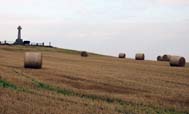Hurley Priory, located on the banks of the River Thames was founded in 1086 by Geoffrey Mandeville I as a cell of Westminster Abbey. After declaring himself head of the English Church, Henry VIII suppressed the priory in 1536 and ownership was transferred to Westminster Abbey. When in 1540 Westminster Abbey was dissolved Hurley Priory passed into lay hands.
Jeff Griffiths from Archaeology in Marlow provides a fascinating account of the village of Hurley and the history of the priory:
The biggest change ever to affect the village happened when Geoffrey de Mandeville founded a Benedictine priory in 1086 in memory of his first wife. The Priory was central to the life of the village for 450 years until Henry VIII’s reforms swept it away in 1536. Its Abbot and monks were more fortunate than most at the Dissolution as they could retreat to the protected mother house at Westminster, taking with them the Priory’s 562 charters, which still exist. These charters reveal that the Abbey of Westminster had exchanged one of its London properties to acquire a forested area near its daughter house. The London property exchanged for Hurley Wood was no less than Covent Garden.
After the Dissolution, Hurley’s monastic estate passed into the hands of John Lovelace in 1545 and this family then became Lords of the Manor. The Lovelaces built a mansion called Ladye Place on the site of the ruined Priory. The first Sir Richard Lovelace went on an expedition with Sir Francis Drake and it’s been said that their fine Elizabethan mansion arose in 1600 from “the legalised piracy of a licensed buccaneer”.
The most significant of the Lovelaces was John, the 3rd Lord Lovelace, who played a significant role in the Glorious or Bloodless Revolution of 1688. He was an ardent anti-Catholic who’d been jailed for complicity in the Rye House plot to assassinate King Charles II and his brother and heir James. Lovelace became a staunch supporter of the cause for the Protestant William of Orange to take over the throne from the Catholic James II. The crypt at Ladye Place, once part of the original Priory, became a centre of plotting and it’s said that fellow aristocratic conspirators would enter by way of underground tunnels that led from the river to the crypt to avoid detection. This crypt, which still stands in private grounds on the old monastic estate at Hurley, became a centre of pilgrimage for those who valued the liberties that had been safeguarded by the plot hatched there. William of Orange and George III both visited this crypt where commemorative tablets record this momentous event in England’s history.
This 3rd Lord Lovelace, however, was a dissolute individual – the Master of an Oxford college said he drank a Quart of Brandy every morning – who left the estate heavily in debt. His son, having no estate to inherit, went to America where he became the Governor of New York State. A township there called Hurley commemorates the link with Lovelace’s Berkshire home. The last Lovelace heir in America died without issue and the line became extinct.
The Elizabethan Ladye Place eventually became derelict and was pulled down in 1838. Much later a smaller house also called Ladye Pace was erected next to the church.
The second house in Hurley to bear the name Ladye Place was purchased in 1924 by Colonel Rivers-Moore, a retired Royal Engineer. He was intrigued by the surrounding monastic remains and determined to undertake archaeological investigations as the site had hardly ever been touched. He was particularly intrigued by the prospect of finding the tomb of Editha, Edward the Confessor’s sister, whose ghost, known as the Grey Lady, was supposed to haunt the place. By a stroke of luck, a particularly dry summer revealed the outline of the old Lovelace mansion, which stood on the remains of Hurley Priory and trial excavations started. It’s reputed that family members then began to have visions of a monk instructing them where to find discoveries and that they held séances to seek guidance as to where they should dig.
In the summer of 2007, a party from the Thames Valley Dowsers investigated the reputed underground tunnel that runs from the Olde Bell hotel [see my previous post] to the remains of the old Priory behind the church. A cupboard in a bar at the Olde Bell reveals a crumbling staircase entrance which is supposed to lead to the tunnels. Next door to the hotel, Hurley House had a trapdoor through which access to the tunnel had been gained. Dowsing highlighted two tunnels that run from the Olde Bell to the old Ladye Place crypt and then to a property known as the Cloisters, the remains of the old Priory behind the church. Set into the Cloisters’ lawns are gratings which cover entrances to underground tunnels that have been explored and led to the moat, underpinning the stories of the plotters in 1688 surreptitiously entering the crypt by tunnel.
I recommend reading Jeff Griffith’s full article; Hurley’s Hidden History.









Henry VIII destroyed so many historic buildings in the 16th century.
What would England look like if Rome approved his divorce from Catherine?
History would be completely different if Rome had made that approval.
What wonders you reveal to us. A place of Benedictines becomes a hive for busy bees intent on overthrowing Catholics. Not that the Catholic monarchs were anyone to write home about, mind you. Henry hisself was a ‘couldabeen’ Great Catholic King but became infected with the same narcissism we see all around us today. From Def Fid to defiling git.
One matter touched upon without explanation was those 562 Charters. Any idea what they were?
Whilst I was researching the post I found this more detailed post, but even this one doesn’t go into much depth.
http://www.british-history.ac.uk/vch/berks/vol2/pp73-77
When I saw your question about the charters I thought that the records were perhaps held at Westminster Abbey but on doing further research I have found out that they are possibly held in the British Library. The charters are written in Latin!
The following book lists the charters and translates 9 of them in the last chapter of the book.
https://archive.org/details/stmaryshurleyin00wethgoog (read on line version)
https://ia800201.us.archive.org/8/items/stmaryshurleyin00wethgoog/stmaryshurleyin00wethgoog.pdf (download PDF version)
When I have the time I am going to read the book in more detail.
Definitely the kind of place I would want to visit, Cherry.
You would love it
Spot on! A very different perspective!
The suggestion here is that the 3rd Lord Lovelace played more than a significant role in the Glorious Revolution of 1688. He was an ardent anti-Catholic who’d been jailed for complicity in the Rye House plot to assassinate King Charles II and his heir James.
I understand why Lovelace became a staunch supporter of the Protestant William of Orange to take over the throne from the Catholic James II. But once William and Mary were safely on the English throne, why did the Ladye Place crypt still need to become a centre of plotting? And why did other aristocrats need underground tunnels that led from the river to the crypt to avoid detection?
My guess is that there was never confidence, on either side, of maintaining the status quo.
I agree. This was more about politics than it was about religion and practising the Christian Faith. Those of the Faith just wanted to practice their Religion without interference by the state.
Tremendous history dear Cherie!
thank you for bringing LOT about this historical place in my knowledge .
I too was interested to learn the fascinating history.